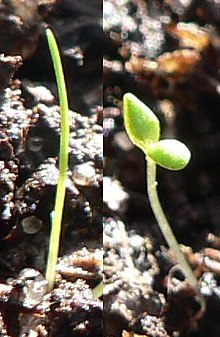**Seedling Development:**
– Seedling develops from plant embryo in a seed
– Typical seedling parts: radicle, hypocotyl, cotyledons
– Monocots have one cotyledon, dicots have two
– Gymnosperms show variation in number of cotyledons
– Some flowering plants have no cotyledons (acotyledons)
**Seedling Growth and Maturation:**
– Seedlings start photosynthesizing when not dependent on seed reserves
– Apical meristems give rise to root and shoot
– Cotyledons senesce as additional leaves develop
– Temperature and light intensity influence seedling growth
– Carbon dioxide enrichment and nitrogen supply affect seedling growth
**Photomorphogenesis and Etiolation:**
– Light-grown dicot seedlings have short hypocotyls and open cotyledons
– Dark-grown seedlings have long hypocotyls and closed cotyledons (etiolation)
– Skotomorphogenesis occurs in the dark, while photomorphogenesis starts in light
– Seedlings sense light through phytochrome and cryptochrome
– Mutations in light receptors can affect seedling development
**Pests and Diseases:**
– Seedlings are vulnerable to pests and diseases
– Damping off is damaging to seedlings
– Cutworms, pillbugs, slugs, and snails are harmful pests
– High mortality rates can result from pest and disease attacks
– Protection measures are essential for seedling health
**Transplanting:**
– Seedlings are transplanted when true leaves appear
– Transplant shock can be reduced with hormone concentrate
– Shade may be necessary in arid or hot areas
– Pricking out is a common transplanting practice in the UK
– Careful handling during transplanting promotes seedling survival
A seedling is a young sporophyte developing out of a plant embryo from a seed. Seedling development starts with germination of the seed. A typical young seedling consists of three main parts: the radicle (embryonic root), the hypocotyl (embryonic shoot), and the cotyledons (seed leaves). The two classes of flowering plants (angiosperms) are distinguished by their numbers of seed leaves: monocotyledons (monocots) have one blade-shaped cotyledon, whereas dicotyledons (dicots) possess two round cotyledons. Gymnosperms are more varied. For example, pine seedlings have up to eight cotyledons. The seedlings of some flowering plants have no cotyledons at all. These are said to be acotyledons.


The plumule is the part of a seed embryo that develops into the shoot bearing the first true leaves of a plant. In most seeds, for example the sunflower, the plumule is a small conical structure without any leaf structure. Growth of the plumule does not occur until the cotyledons have grown above ground. This is epigeal germination. However, in seeds such as the broad bean, a leaf structure is visible on the plumule in the seed. These seeds develop by the plumule growing up through the soil with the cotyledons remaining below the surface. This is known as hypogeal germination.
